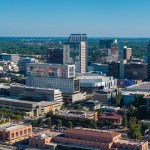■ Multifamily rents increased by 2.5% year-over-year in May, which is almost exactly where rent growth was in March 2020 when the pandemic began spreading in the U.S. Many metros have recovered and surpassed pre-pandemic rent growth numbers.
■ Rents grew $12 in May to $1,428, the largest one-month increase in our data set’s history. The 0.8% month-over-month growth rate was the largest since June 2015. For the second month in a row, all top 30 metros had positive MoM rent growth and 90% had MoM gains of 0.5% or more.
■ Yardi Matrix now includes single-family rental units exclusively in built-to-rent communities. Our data set covers more than 90,000 units nationwide. The pandemic has driven demand for single-family rentals, and the SFR industry boasted 7.3% year-over-year rent growth as of May.
The U.S. economy continues to show strength, as more than 50% of Americans have received at least one COVID vaccine shot. The Centers for Disease Control and Prevention (CDC) has advised that fully vaccinated people no longer need to wear masks. Most states have followed suit and have dropped mask mandates and all other COVID-19 restrictions as the U.S. gears up for a busy summer full of travel and gatherings.
Nationally, there is little weakness left in the multifamily sector. YoY rent growth is back to prepandemic levels, and rents on a dollar amount basis increased the most in a single month in the history of our data set.
While all gateway markets are showing signs of recovery, some are recovering faster than others. In New York, rents increased by 3.4% on a month-over-month basis, well above all other top 30 metros.
Banks in New York, like Goldman Sachs and JP Morgan Chase & Co., have mandated that workers return to the office this summer. This, coupled with lower rents in New York driven by the pandemic, has likely contributed to an increase in demand.
On the other hand, Seattle (0.2% MoM) and San Francisco (0.3% MoM) are rebounding, but at a much slower pace. Part of the difference in rebound could be due to the type of industries concentrated in each city and their return-to-work plans.
New York has a large concentration of banks with employees required to return to the office this summer, whereas Seattle and San Francisco have a large concentration of tech workers that are more likely to be able to work on a hybrid or fully remote schedule.
Read the full Matrix Multifamily National Report-May 2021











Add Comment